The Victor-Victrola Page
Needles
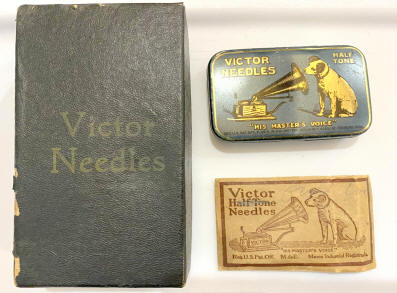 Victor
needles were
typically made of soft steel, and are often available in "LOUD", "MEDIUM" and
"SOFT" tone configurations. The only differences between these types are in the
thickness (diameter) of the needle shank. The thicker the needle, the more
vibration is transferred from the record to the soundbox, and thus the greater
the volume. Victor manufactured and marketed their own needles, as this was a
very lucrative business. Steel needles were originally sold in packets, "tins",
or cardboard boxes as seen at left.
Victor
needles were
typically made of soft steel, and are often available in "LOUD", "MEDIUM" and
"SOFT" tone configurations. The only differences between these types are in the
thickness (diameter) of the needle shank. The thicker the needle, the more
vibration is transferred from the record to the soundbox, and thus the greater
the volume. Victor manufactured and marketed their own needles, as this was a
very lucrative business. Steel needles were originally sold in packets, "tins",
or cardboard boxes as seen at left.
Steel needles should be used only once (one side of one record) to avoid excessive wear of the record, so it is likely that any needles you have found rolling around inside your phonograph have already been used. They should be trashed. Used needles have no value whatsoever, so get rid of them! This would not be the case if the needles are still in a sealed packet; those can be used without issue. New steel needles are still readily available from a number of sources (see our RESOURCES page), and they are not expensive.
There were literally thousands of
different brands of needles produced in the early years of the 20th
Century, and some of them utilized unique "bent" or "twisted" designs.
Some hardly look like needles at all. One could spend a lifetime
collecting different needle types, and probably never come-across all
the brands and designs that were manufactured. Colorful and ornate
needle tins were also unique to each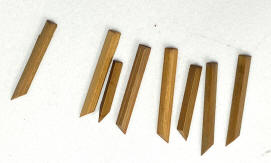 manufacturer, and many collectors prize these tins today.
manufacturer, and many collectors prize these tins today.
Several non-steel needles were produced by Victor over the years. One was a "Fiber" type needle, which was simply a shaved piece of bamboo that could be re-sharpened and reused (right). Victor sold little "sharpening kits" so that customers could re-point them after every few plays. These bamboo needles tended to reduce record wear, but sound far more "muted" than do steel needles.
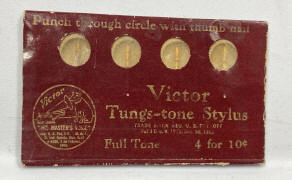 In
1924, Victor introduced the "Tungstone" multi-play needle, which
(according to Victor's advertising) could last up to 200 plays. This was
mostly advertising hype...in most cases 50 to 60 plays per needle was
all that could be achieved.
These products consisted of
a brass or steel shank with a small "point" protruding from one end.
This point is made of a tungsten alloy, which is much softer than the
grooves of records. Tungstone needles are no longer manufactured,
but they still show-up at auctions and on Ebay in their original small
tin containers or cardboard "punch-out" packs (left). A Tungstone needle
may be used to play stacks of records until it ceases working (at which
time it is worn out and will no longer be visible as a small protrusion
from the shank). If you find a Tungstone needle, rub your finger along
the smaller end, and you should be able to feel a small point protruding
from the shank. It doesn't protrude very much! If it is totally smooth,
then the tungsten element has already been worn away, and the needle
must be tossed-out.
In
1924, Victor introduced the "Tungstone" multi-play needle, which
(according to Victor's advertising) could last up to 200 plays. This was
mostly advertising hype...in most cases 50 to 60 plays per needle was
all that could be achieved.
These products consisted of
a brass or steel shank with a small "point" protruding from one end.
This point is made of a tungsten alloy, which is much softer than the
grooves of records. Tungstone needles are no longer manufactured,
but they still show-up at auctions and on Ebay in their original small
tin containers or cardboard "punch-out" packs (left). A Tungstone needle
may be used to play stacks of records until it ceases working (at which
time it is worn out and will no longer be visible as a small protrusion
from the shank). If you find a Tungstone needle, rub your finger along
the smaller end, and you should be able to feel a small point protruding
from the shank. It doesn't protrude very much! If it is totally smooth,
then the tungsten element has already been worn away, and the needle
must be tossed-out.
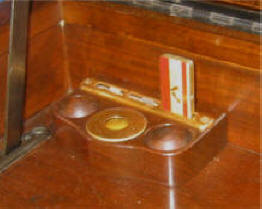
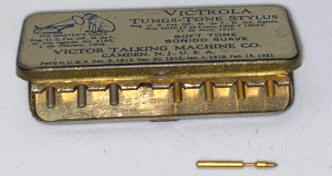 For
Victrola machines, needles should be
stored in the little "cups" along the side of the motorboard (picture on
right). Loud needles go in one cup, soft needles in the other and the
center cup is where the used needles should be placed. When the center cup
fills-up with used needles, you dump them in the trashcan. The metal (gold
or nickel-plated) needle disposal
cup (center position) is often still found in many Victrolas. It is humorous
to note that many EBay sellers seem to take great pride in the fact that
their phonograph has 5 needles still sitting in the cup, and that this
somehow adds "value" to the machine. First, they cost about 2 cents each, and
second, they have probably already been used 20 times, and belong in the
trash can.
For
Victrola machines, needles should be
stored in the little "cups" along the side of the motorboard (picture on
right). Loud needles go in one cup, soft needles in the other and the
center cup is where the used needles should be placed. When the center cup
fills-up with used needles, you dump them in the trashcan. The metal (gold
or nickel-plated) needle disposal
cup (center position) is often still found in many Victrolas. It is humorous
to note that many EBay sellers seem to take great pride in the fact that
their phonograph has 5 needles still sitting in the cup, and that this
somehow adds "value" to the machine. First, they cost about 2 cents each, and
second, they have probably already been used 20 times, and belong in the
trash can.
The "slots" in the back of the needle cups (on later-vintage machines) were used to hold the Tungstone needle tins.
External-horn Victors do not have needle cups.
IMPORTANT: Never used diamond or sapphire-tipped needles on early acoustic or electric phonographs. These needles were intended for use only on post-1940 machines which had a much lighter tonearm. Using a gem-tipped needle on an early Victor or Victrola is a sure-fire way to destroy your records very quickly!

